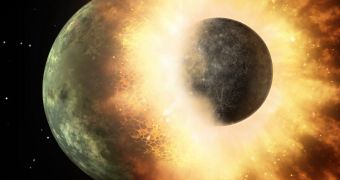Astronomers have been struggling to explain numerous odd properties displayed by Mercury and Uranus for many years now, but leading theories were just discredited over the past few days. Now, astronomers begin to search for new explanations of what actually happened.
This line of inquiry is very difficult to push forward, since obtaining answers would require a deep understanding of how the solar system looked like in its earliest days, when the planets were just forming. This is obviously impossible to figure out in minute detail.
In other words, the way the solar system and its planets look like now was decided more than 4 billion years ago. The thing that puzzles experts most about Mercury is its large iron core, which lies close to the surface, Similarly, they cannot explain why Uranus lies at a steep angle while orbiting the Sun.
In the past, scientists have proposed that a huge portion of Mercury's crust may have been stripped away following a monumental cosmic collision that involved another protoplanet in the early solar system.
The same type of event may have contributed to tilting Uranus' axis in orbit, forcing the gas giant to exhibit its current weird looks. But these scenarios fell in 2011, as new data became available for study.
The NASA Mercury Surface, Space Environment, Geochemistry and Ranging (MESSENGER) space probe provided data that utterly contradict the impact theory for the solar system's innermost planet.
As for Uranus, the thing that drove the final nail through the previous theory's coffin was the discovery that its moons still orbited in its equatorial plane. If an impactor had slammed the gas giant, then the moons would have had no reason to be in this position.
According to University of California in Santa Barbara (UCSB) physicist Stanton Peale, the impact hypothesis also can't explain why Pluto's moons orbit so weirdly around the dwarf planet. At a recent convention, astronomers proposed new explanations for the oddities these space bodies display.
Harvard University planetary scientist Sarah Stewart said that Mercury could have been impacted by another object in a manner that allowed it to retain the volatile compounds MESSENGER discovered.
The announcement was made a joint meeting of the European Planetary Science Congress and the Division for Planetary Sciences of the American Astronomical Society, ScienceNow reports.
French astronomer Alessandro Morbidelli, who is based at the Observatoire de la Côte d'Azur in Nice, also presented new data to indicate what kind of impact may have modified the entire Uranian system the way it did.
“You only lose volatiles if they somehow can get separated from the heavier, more refractory elements. For instance, our own moon is low in volatile elements because it slowly coalesced from a churning, hot disk of material surrounding the Earth,” Stewart says.
“But in the case of Mercury, the impact debris cooled pretty quickly, so most of the potassium and sulfur was preserved,” the expert adds, thus explaining MESSENGER's readings.
In turn, Morbidelli proposed that Uranus was indeed affected by a collision, but argued that the event occurred significantly earlier in time than first calculates. At the same time, changing this planetary system required multiple impacts.
“In the early days of the solar system, there may have been many hundreds of protoplanets drifting around in the system's outer regions. Giant collisions were, of course, more likely to occur very early on,” the astronomer concluded.

 14 DAY TRIAL //
14 DAY TRIAL //